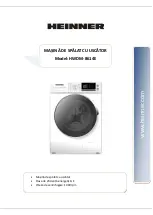
COMMANDER
INSTALLATION MANUAL
7
Mechanical Installation
Removal of additional packing materials
Remove the following to ensure proper operation:
• Strapping around XE validator (if optioned)
• Tape around Cashflow validator (if optioned)
• Tape around the coin mechanism
• Tape from the coin/token box that secures the receipt paper for shipping
Positioning
There are no set guidelines for the placement of Commander. However, it is recommended that the machine
is positioned far enough away from the wash entrance to minimize the amount of over spray that may reach
the unit.
The recommended height from the pavement to the bottom of the Commander cabinet is approximately 32”
- this ensures customers in most vehicle types can interact with Commander without excessive overreach.
Mounting
Commander must be securely mounted by using one of the following methods:
BRICK MOUNTING
Uses a custom-built brick or concrete enclosure to house Commander
. See Figures 2.1 - 2.4 on pages 8 &
9 for mounting hole locations.
Commander provides for three (3) 5/8” mounting holes. Have your engineer
or contractor recommend a construction method suitable for strength and stability.
BASE MOUNTING
This method involves mounting Commander on an optional base. The base is secured to the pavement or
curb, and Commander is then secured to the base. The type of fasteners used should be recommended
by your engineer as to strength and suitability.
Running Conduit
Typical electrical code requires low and high voltage wiring to be run in separate conduits. Commander has
three (3) 1 1/8” conduit mounting holes in the back of the cabinet, as well as three (3) 1 1/8” conduit holes
in the bottom of the cabinet.
• Conduit carrying high voltage 120VAC power lines, should be connected to either one of the bottom
or back conduit holes, as viewed from the front of the machine. These conduits are designated only
for 110v for the power supply.
• Conduit carrying lines with 24VAC, 24VDC, 12VAC or 12VDC signals should be connected to any of
the open conduit holes.
• External communication lines (Cat 5 or Cat 5E, Video, POS etc.) should be run through separate
conduit and connected to any of the open conduits.
NOTE: free-standing cabinets do not have conduit holes in the back.








































